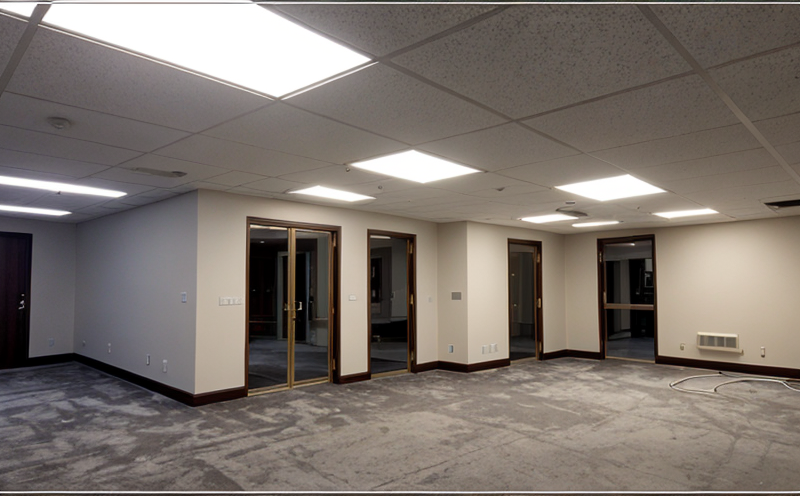ASTM E96 Moisture Transmission Testing of Decorative Lighting Materials
The ASTM E96 standard is a critical tool in evaluating the moisture resistance properties of decorative lighting materials used in architectural and interior design applications. This test measures the rate at which water vapor can permeate through various materials, ensuring that they meet stringent quality and safety standards.
Lighting fixtures, panels, and other decorative elements are exposed to high humidity environments to simulate real-world conditions where moisture can accumulate. The test assesses how effectively these materials can resist the ingress of moisture, which is essential for preventing corrosion, mold growth, and structural degradation over time.
The ASTM E96 method involves placing a sample in a chamber with controlled humidity levels on one side and dry air on the other. The rate at which water vapor passes through the material is measured by monitoring changes in weight or using sensor technology. This process allows for precise determination of the moisture permeability index (MPI), which indicates how well a given material can withstand exposure to moisture.
For accurate ASTM E96 testing, specimens need careful preparation to ensure consistent and reliable results. Proper sample handling is crucial; this includes cutting samples into standard sizes, ensuring flat surfaces, and avoiding contamination with any external substances that could affect the test outcomes. The choice of specimen size can vary depending on the specific requirements set forth by ASTM standards.
After preparing the specimens, they are placed in the chamber under specified conditions of humidity and temperature for a defined period. During this time, sensors continuously monitor the weight gain or loss due to moisture transfer across the material's surface. Once testing is complete, data points are collected and analyzed using statistical methods to calculate the MPI.
The results obtained from ASTM E96 tests play an important role in product development by helping manufacturers identify potential weaknesses early on and make necessary adjustments before introducing products into marketplaces. Compliance with this standard ensures that decorative lighting materials meet industry expectations regarding durability, safety, and performance under various environmental conditions.
- Ensures compliance with international standards such as ASTM E96
- Provides critical insights into material performance in humid environments
- Supports design teams in selecting appropriate materials for specific applications
- Promotes durability and extends product lifespan through rigorous quality control measures
Why It Matters
The importance of ASTM E96 moisture transmission testing cannot be overstated, especially when dealing with decorative lighting materials that are exposed to humid environments. In architectural and interior design projects, the use of improperly selected or manufactured materials can lead to significant problems down the line.
One key concern is the potential for corrosion within fixtures containing metal components. Moisture ingress into these areas can accelerate oxidation processes, leading to premature failure of electrical connections and other metallic parts. Another issue arises from mold growth on surfaces where moisture accumulates; this not only affects aesthetics but also poses health risks if spores enter the air circulation system.
From a broader perspective, failing to meet ASTM E96 standards could result in legal liabilities for manufacturers and suppliers alike. Consumers expect products they purchase to function correctly over extended periods without requiring frequent replacements or repairs. By adhering to these testing protocols, companies demonstrate their commitment to producing high-quality goods that stand up to rigorous scrutiny.
Moreover, certification against ASTM E96 enhances a company’s reputation among customers who prioritize sustainable practices and longevity in their purchases. It also opens doors to international markets where stringent quality assurance measures are required by law or industry practice.
Eurolab Advantages
At Eurolab, our expertise lies not only in conducting ASTM E96 moisture transmission tests but also in ensuring that all aspects of the process adhere strictly to established protocols. Our team comprises highly skilled professionals who bring years of experience directly into every project they undertake.
We offer several advantages over other laboratories offering similar services:
- State-of-the-art facilities equipped with advanced instrumentation capable of delivering accurate and reproducible results
- Dedicated staff trained specifically in performing ASTM E96 tests according to current guidelines
- Prompt turnaround times while maintaining high standards of accuracy and reliability
- Comprehensive reporting tailored to meet clients' needs, including detailed interpretations based on test findings
In addition, Eurolab provides additional services that complement our core offering. These include assistance with sample preparation, consultation regarding material selection, and advice on best practices for incorporating moisture resistance into designs.





